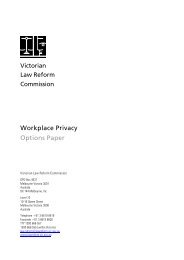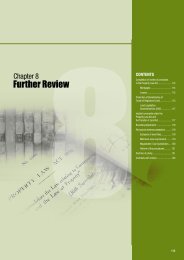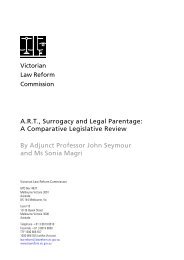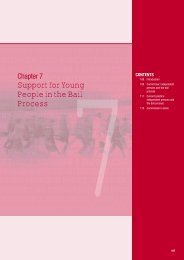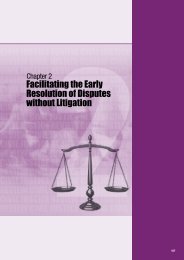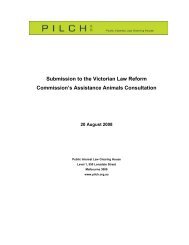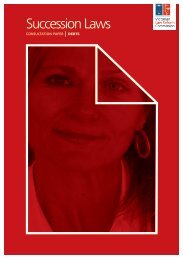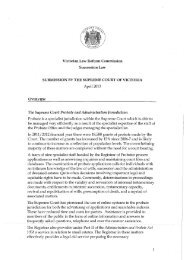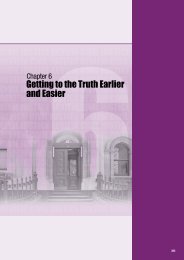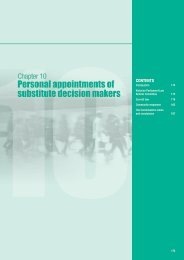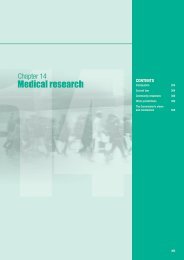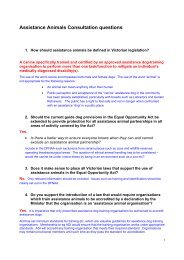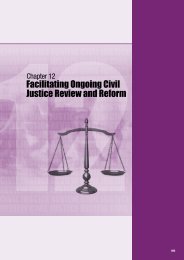Crimes Mental Impairment consultation paper.pdf - Victorian Law ...
Crimes Mental Impairment consultation paper.pdf - Victorian Law ...
Crimes Mental Impairment consultation paper.pdf - Victorian Law ...
Create successful ePaper yourself
Turn your PDF publications into a flip-book with our unique Google optimized e-Paper software.
9<br />
9.23 First, it is difficult to demonstrate that a person subject to a supervision order will<br />
not pose a serious or likely danger following a change in the level of supervision. As<br />
Freckelton observes, having to satisfy a ‘negative’ or that something will not happen, is<br />
difficult to prove. 14<br />
9.24 Secondly, assessing dangerousness could be subject to much subjective interpretation—<br />
assessing future risk requires the court to embrace notions of uncertainty and to consider<br />
the ‘likelihood of such [future] risk becoming a reality’. 15 The interpretation of the term<br />
‘serious endangerment’ has been ‘somewhat elastic’. 16 The CMIA does not define what<br />
the term means, for example, whether it requires the endangerment to be physical<br />
or psychological, or whether it requires the risk that an actual violent offence will be<br />
committed (as opposed to a non-violent offence). The use of ‘likely to endanger’ in<br />
some parts of the CMIA and ‘seriously endanger’ in others also implies that different<br />
thresholds for court intervention apply at different stages of the process, that could add<br />
to the subjectivity.<br />
9.25 Thirdly, using dangerousness as the basis of a decision raises the question of whether<br />
this could lead to overly cautious decision making (discussed later in the chapter at<br />
[9.51]–[9.58]) and if this is the case, whether the criteria the court considers should be<br />
based on something other than dangerousness. Carroll, Lyall and Forrester distinguish<br />
between two types of legislation: ‘disorder’ based legislation and ‘risk’ based legislation.<br />
9.26 The ‘disorder’ based approach, taken in England and Wales and some jurisdictions in the<br />
United States, relies on the same criteria for the detention of forensic patients as for civil<br />
patients. This approach requires an ongoing mental disorder. 17 In England and Wales,<br />
the <strong>Mental</strong> Health Review Tribunal must discharge a person subject to an unrestricted<br />
hospital order on a number of criteria. The person must be discharged if the Tribunal is<br />
not satisfied:<br />
• that they are suffering from a mental disorder that makes it appropriate for them to<br />
be detained in a hospital<br />
• that it is necessary for the health or safety of the patient or of other people<br />
• that appropriate medical treatment is available for them. 18<br />
9.27 Further, in that jurisdiction the court may revoke a supervision order if it would be in the<br />
interests of the health or welfare of the person. 19<br />
9.28 Victoria adopts the ‘risk based’ approach. Under this approach the criteria for detention<br />
and supervision relate not to the persistence of the person’s mental disorder, but to the<br />
risk of harm to others (and, to self, in some cases). 20<br />
9.29 Some other Australian jurisdictions use the ‘risk’ based approach. However not all of them<br />
use ‘danger’ as the basis for their tests. In Western Australia, for example, the <strong>Mental</strong>ly<br />
Impaired Accused Review Board considers ‘the degree of risk that the release of the<br />
accused appears to present to the personal safety of people in the community or of any<br />
individual in the community’ when deciding whether to grant leave. 21 In Queensland, the<br />
<strong>Mental</strong> Health Court must not revoke a forensic order ‘unless it is satisfied the patient<br />
does not represent an unacceptable risk to the safety of the patient or others’. 22<br />
14 Ian Freckelton, ‘Applications for Release by Australians in Victoria Found Not Guilty of Offences of Violence by Reason of <strong>Mental</strong> <strong>Impairment</strong>’<br />
(2005) 28 International Journal of <strong>Law</strong> and Psychiatry 375, 383.<br />
15 Re LN [1999] VSC 144R (6 May 1999) [6].<br />
16 Ian Freckelton, ‘The Preventive Detention of Insanity Acquitees: A Case Study from Victoria’ in Bernadette McSherry and Patrick Keyzer<br />
(eds) Dangerous People: Policy, Prediction and Practice (Routledge, 2011) 89.<br />
17 Andrew Carroll, Mark Lyall and Andrew Forrester, ‘Clinical Hopes and Public Fears in Forensic <strong>Mental</strong> Health’ (2004) 15(3) Journal of Forensic<br />
Psychiatry and Psychology 407, 417.<br />
18 <strong>Mental</strong> Health Act (UK) s 72(1).<br />
19 Criminal Procedure (Insanity) Act 1964 (UK) sch 1A cl 9(1).<br />
20 Carroll, Lyall and Forrester, above n 17, 418. New South Wales has a similar approach to Victoria. Section 39(2) of the <strong>Mental</strong> Health<br />
(Forensic Provisions) Act 1990 (NSW) requires the court to be satisfied that ‘the safety of the person or any member of the public will not be<br />
seriously endangered by the person’s release’.<br />
21 Criminal <strong>Law</strong> (<strong>Mental</strong>ly Impaired Accused) Act 1996 (WA) s 28(3).<br />
22 <strong>Mental</strong> Health Act 2000 (Qld) s 204.<br />
191



